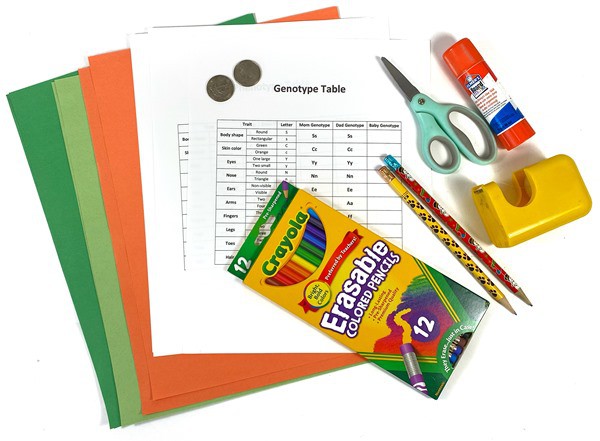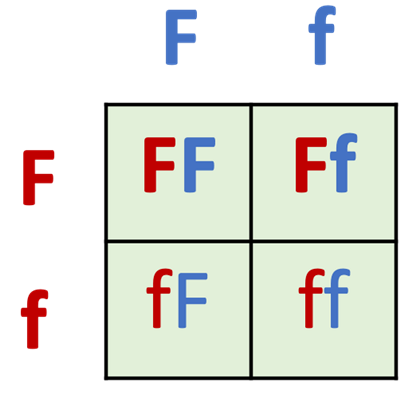Summary
Overview
In this lesson, students will model how traits are passed on from parents to their offspring by creating baby aliens based on their parents' traits. As students compare the physical features of their alien families, they will be able to make the connection between an organism's genotype and phenotype. Students will also learn the difference between dominant and recessive traits.
Learning Objectives
- Simulate genetic transmission from parents to their offspring using a model.
- Describe how genetic variation is caused by sexual reproduction.
- Explain the connection between an organism's genotype and phenotype.
NGSS Alignment
This lesson helps students prepare for these Next Generation Science Standards Performance Expectations:- MS-LS3-2. Develop and use a model to describe why asexual reproduction results in offspring with identical genetic information and sexual reproduction results in offspring with genetic variation.
|
Science & Engineering Practices
Developing and Using Models.
Develop and use a model to describe phenomena.
Constructing Explanations and Designing Solutions. Apply scientific ideas, principles, and/or evidence to construct, revise and/or use an explanation for real-world phenomena, examples, or events. Analyzing and Interpreting Data. Analyze and interpret data to provide evidence for phenomena. |
Disciplinary Core Ideas
LS1.B: Growth and Development of Organisms.
Organisms reproduce, either sexually or asexually, and transfer their genetic information to their offspring.
LS3.A: Inheritance of Traits. Variations of inherited traits between parents and offspring arise from genetic differences that result from the subset of chromosomes (and therefore genes) inherited. LS3.B: Variation of Traits. In sexually reproducing organisms, each parent contributes half of the genes acquired (at random) by the offspring. Individuals have two of each chromosome and hence two alleles of each gene, one acquired from each parent. These versions may be identical or may differ from each other. |
Crosscutting Concepts
Cause and Effect.
Cause-and-effect relationships may be used to predict phenomena in natural systems.
|
Materials
 Image Credit: Svenja Lohner, Science Buddies / Science Buddies
Image Credit: Svenja Lohner, Science Buddies / Science Buddies
For teacher:
- Printout of Physical Traits Images
- Printout of Sibling Images
For each student:
- Printout of the Alien Genotype Table and Alien Phenotype Table
- Construction paper, different colors (orange and green must be included)
- Scissors
- Tape
- Glue
- Markers, crayons, or coloring pens
- Pencils
- Two coins
You can also let students draw their alien babies instead of building them from construction paper. In this case, the construction paper, scissors, tape, and glue are not necessary.
Background Information for Teachers
This section contains a quick review for teachers of the science and concepts covered in this lesson.It was Gregor Mendel, a monk and scientist, who first discovered in the 1860's that some traits are passed down from generation to generation in very clear and predictable patterns. Today, we know that offspring inherit half of their DNA from each parent. Thus, our genome contains two copies of every gene (one copy from the mother and one copy from the father). Many genes come in several different versions, called alleles. Alleles, or gene variants, arise when the DNA sequence of a gene is changed due to mutations. This means that no two people have the exact same set of genes (identical twins come the closest, but even they have differences). Siblings, who originate from the same genetic material (their parents' DNA), share some traits, but others are different. This is because each parent has two copies of every gene and either copy can be passed on to their offspring. Which gene a given offspring will get is random, and thus can vary from sibling to sibling. As a result, each of the siblings will only share part of their genes, and thus traits, with the other siblings.
When you have inherited two identical alleles (or gene variants), you are said to be homozygous for that gene. People with two different alleles are heterozygous for that gene. The set of alleles a person has is called their genotype. A genotype determines the phenotype, the observable characteristics (or traits) that the genotype codes for. Some traits, called Mendelian traits, are due to a single gene. Two examples of Mendelian traits are a cleft chin or face freckles. In genetics, scientists often abbreviate such traits with letters. These letters are often chosen so they relate to the trait, like the letter F to represent face freckles. Sometimes a gene only has two alleles, one of which is dominant and the other recessive. If you have just one copy of a dominant allele, you will display that trait. Scientists denote a dominant allele by a capital letter (F versus f). You need two copies of a recessive allele to display that trait. Recessive alleles are usually denoted by a lowercase letter (f versus F).
Because alleles are randomly assigned during sex cell production, offspring can end up with different combinations of alleles relative to one another. If you know the alleles of the parents, you can predict the probability of an offspring having a particular set of alleles. For Mendelian traits, scientists use a Punnett square diagram to visualize the alleles of parents and their offspring (Figure 1).
 Image Credit: Svenja Lohner, Science Buddies / Science Buddies
Image Credit: Svenja Lohner, Science Buddies / Science BuddiesA square with four boxes. Uppercase F and lowercase f are on the left side of the square. Uppercase F and lowercase f are the top of the square. In the square: Uppercase F and uppercase F in the first box on the top. Uppercase F and lowercase f in the second box on the top. Lowercase f and uppercase F in the first box on the bottom. Lowercase f and lowercase f in the second box on the bottom.
Figure 1. A Punnett square visualizes the possible combinations (green) of maternal alleles (red) with paternal alleles (blue). In this example, F is the dominant allele for face freckles, whereas f represents the recessive allele for no face freckles.
Figure 1 shows that parents with a dominant phenotype can have offspring with either the dominant or the recessive phenotype. Scientists can use these rules of inheritance to examine generations within a biological family and discover the mode of inheritance for a specific human trait. To do this, scientists create family trees, called pedigrees, showing as many generations of a biological family as they can and marking who has which phenotype. Human pedigrees are also a powerful screening tool for certain diseases. Exactly like physical traits, genetic disorders of human beings that originate from a gene defect can be dominant or recessive. By examining a pedigree for where genetic diseases arise, scientists can deduce how the condition is inherited.
In this lesson, students will model how traits are passed on from parents to their offspring by creating baby aliens based on their parents' traits. As students compare the physical features of their alien families, they will be able to make the connection between an organism's genotype and phenotype. Students will also learn the difference between dominant and recessive traits.




